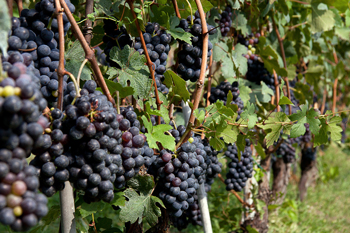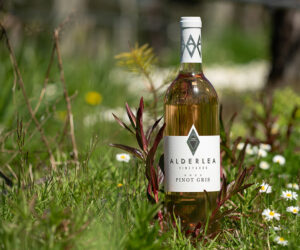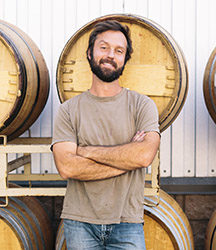 I was researching the literature for this article and came across a very weighty thought. The passage was in Jancis Robinson’s “Bible” titled Wine Grapes, and she writes that this grape is so old; its parents are probably extinct! The first known written history from this grape goes back to 1266 A.D. But this variety has survived for another 600 years and still going strong. Now that is success! Why? Finding a variety selection and nurturing it so that it performs well under the conditions it is grown is the way to make the best wines possible in any region of the world. When you find success, do not change — that’s what the Northern Italians have done. There is also a movement alive in California to study it further as well. Therefore, we have a grape with a long storied history in Italy, and one that may have a long future here. Nebbiolo: Whose passionate followers are paving the way to bring this grape to the rest of the world.
I was researching the literature for this article and came across a very weighty thought. The passage was in Jancis Robinson’s “Bible” titled Wine Grapes, and she writes that this grape is so old; its parents are probably extinct! The first known written history from this grape goes back to 1266 A.D. But this variety has survived for another 600 years and still going strong. Now that is success! Why? Finding a variety selection and nurturing it so that it performs well under the conditions it is grown is the way to make the best wines possible in any region of the world. When you find success, do not change — that’s what the Northern Italians have done. There is also a movement alive in California to study it further as well. Therefore, we have a grape with a long storied history in Italy, and one that may have a long future here. Nebbiolo: Whose passionate followers are paving the way to bring this grape to the rest of the world.
Nebbiolo’s History
Piemonte, in northern Italy, is the ancestral home to Nebbiolo. The grape accounts for 75% of the total area planted and has numerous references to it from 1266 onward. Sub-region Alba in 1292 references filagnos de vitibus neblorii, Canale in 1303; vino nebiolo, Moretta in 1324-5, Nubliolio, and in Bricherrasio (vites de nebiolo) in 1328-9. These terms are derived from a combination of Latin and Italian from the root, nebbia, which translates to “fog.” There is some speculation as to whether it refers to the fog that covers the hills during harvest, but it probably refers to the thick natural bloom that covers the ripe berries, as if they were covered in a layer of fog. According to Robinson, grape names are more likely to take on the characteristic of the plant, and not the local climate. As evidenced and supported by a synonym of Nebbiolo, that being Prünent, from the root prina, meaning “bloom.” There is some discussion that it could be confused with prugna, meaning “plum,” which could be a reference to the tradition of growing grapes together with plum trees.
This long history has led to an understanding of the variety’s variability brought about by centuries of clonal propagation. Cuttings of Nebbiolo being distributed around the region began to adapt to the local microclimates. These local microclimates will influence how a variety presents itself from budbreak timing, flowering, cluster size, ripening characteristics, and harvest timing. Today, four main types have been agreed upon:
Nebbiolo Lampia
Nebbiolo Michet
Nebbiolo Rosé
Nebbiolo Bolla
Of these, the rosé has been determined to have a similar but different DNA profile. This makes it completely separate from the red version. Michet has identical DNA to the most widespread Lampia, but it is infected with Grape Fanleaf Virus (GRLV), so it exhibits different morphological characteristics. Bolla is identical as well but decreasing in importance for reasons I could not determine. This type of nuance goes to show how local knowledge and perception of a variety are important, but when science gets involved, it changes that perception. In the case of the Old World, I see science being the curiosity, but traditions do not change.
There are several parent-offspring relationships as well. The rosé form is actually the offspring of Nebbiolo, which explains its similar DNA profile. Freisa, a red grape is very closely related, and Freisa is closely related to Viognier, indicating Nebbiolo and Viognier are cousins. There are other varieties, significant locally in sub-regions of Piemonte, that are related to Nebbiolo. This indicates a previous presence of Nebbiolo in these areas. Some geneticists have introduced the theory that these local varieties possibly could be Nebbiolo’s parents. You gotta love science! I always knew I hated genetics!
Nebbiolo Viticulture
Viticulturally, it buds early and ripens late, so its growing sites are reserved to south and west facing slopes with calcareous marls. The soils in which it is grown is important, and it is likened to Pinot Noir in its ability to express its site — something referred to as terroir in some circles. They are grown in Barbaresco and Barolo regions of the Piemonte, and carry the designations of DOC and DOCG, which stands for Denominazione di Origine Controllata e (Garantita) and translates to English as Denomination of Controlled and Guaranteed Origin. DOC and DOCG are both considered quality classifications. Under Italian wine law, DOCG is the highest designation of quality. However, what can be assured in either case, the wine’s origin can be guaranteed. Nebbiolo grown in sub-optimal soils or conditions tend to be light in color, and turn orange with bottle age and may carry the DOC designation, but not DOCG.
Nebbiolo Enology
Winemaking styles are varied and directed by marketing approach. I regularly attend trade tastings where the best wines are showcased. Typical vinifications consist of de-stem and crush, perhaps some whole berry influence, de-acidulation via the malolactic fermentation, (it is generally high in acid) but one tasting more interesting than any other was in the living area of a local vintner in the village of Oira, in northern Italy. They invited the entire group of eighteen students and three chaperones into the room and hosted a food and wine tasting. One of the last wines of the afternoon was a Prünent. At the time, I did not know this was Nebbiolo. Inquiring to the winemaking process, I was intrigued the wine they were serving was the prior year’s vintage. I was told there was no oak or oak products and it was bottled because it was ready to drink. It turns out he was the local village winemaker and this was their culture of winemaking, and their culture of Nebbiolo. Essentially, it was their “house wine.” At my house I liken it to when you run out of wine, it is time to bottle.
Another aspect of Nebbiolo winemaking is the unstable anthocyanins that the grape is known for, leading to premature indication of oxidation. The wine takes on an orange or brown hue. I have experienced this with California Nebbiolo. It was a wine we thought would age, and when we pulled it from the cellar five years later, it was disappointing. I did not know then what I know now, and if I were to make Nebbiolo I would research techniques in color stabilization. Color stabilization is practiced in other varieties, like Sangiovese. In that case, we added commercial tannins at the crusher, to provide some phenolic substrate to participate in the co-pigmentation process (see “Techniques” on page 52 for more information on this). Another simpler, straight-forward method is extended maceration — leaving the must on the skins and seeds after the alcoholic fermentation is complete. Each method will help, but they also have their drawbacks. The former, being added costs and not knowing the correct amount to add. My recommendation is to be conservative with the manufacturer’s guidelines in that you are adding tannin to an already tannic grape. Never add more than you are willing to take away if need be. With extended maceration, there is always the danger of oxidation due to poor headspace management. Keep covered and a layer of inert gas over the top of the must. Extended maceration leads to increased release of seed tannin, which can lead to bitterness. Stir the must daily, and taste. When you detect bitterness, it is time to press. Do not let this go longer than a week though. Moreover, as always, make sure you protect the headspace during this period when you cover it back up.
Nebbiolo’s Future
Its success in Italy has led to experimentation elsewhere. In Europe, there are plantings in the south of France, Switzerland, and Austria. In the southern hemisphere, Argentina, Chile, South Africa, and Australia have plantings. In the United States, it can be found in California and the drier regions of Washington State. Oregon, Virginia, Tennessee, Pennsylvania, Idaho, and New Mexico also report acreage.
Where is Nebbiolo going? With respect to California, where other Italian varieties have had success, there is a group working to understand Nebbiolo better. This is a project where clones of the variety are to be planted and evaluated for differences when grown on the same site. In this manner, the researcher can determine the best clones for that site. In a perfect world, these plantings are replicated across several sites in the state, but funding is limited in that there is not a big public perception that Nebbiolo is actually a grape. The average consumer will only recognize the names Barolo and Barbaresco, and their DOC and DOCG significance. The project holds promise but it will be several years before any results are available.
Nebbiolo is the perfect example of a variety that the locals have cultivated for hundreds of years and understand best from a viticultural, enological, and economic perspective. Whether this success can extend to other areas of the globe and last another 600 years is anyone’s guess. What it takes is people with a pioneering spirit and curiosity. I will look to toast my next glass of Barolo/Barbaresco, or rather Nebbiolo (if you prefer) sometime soon. I hope you do as well.
Nebbiolo Recipe
Ingredients
125 pounds (57 kg) fresh Nebbiolo fruit
Distilled water
10% potassium metabisulfite (KMBS) solution. Weigh 10 grams of KMBS, dissolve into about 50 milliliters (mL) of distilled water. When completely dissolved, make up to 100 mL total with distilled water.
5 grams Lallemand EC-1118
10 grams Di-ammonium Phosphate (DAP)
10 grams Go-Ferm
10 grams Fermaid K (or equivalent yeast nutrient)
Malolactic fermentation starter culture (CHR Hansen or Equivilent)
Other equipment or needs
15-gallon (57-L) food-grade plastic bucket for fermentation
5-gallon (19-L) carboy
(1-2) 1-gallon (4-L) jugs
Racking hoses
Destemmer/Crusher
Wine press
Inert gas (nitrogen, argon, or carbon dioxide)
Ability to maintain a fermentation temperature of 85–90 °F (30–32 °C).
Thermometer capable of measuring between 40–110 °F (4–43 °C) in one degree increments.
Pipettes with the ability to add in increments of 1 mL
Tartaric acid – addition rate is based on acid testing results.
Step by Step
1. Clean and sanitize all your winemaking tools, supplies and equipment.
2. Crush and destem the grapes. Transfer the must to your fermenter.
3. During the transfer, add 15 milliliters of 10% KMBS solution (This addition is the equivalent of 50 ppm SO2). Mix well.
4. Take a sample to test for Brix, acidity and pH.
5. The next day suspend the Fermaid K in a little distilled water (usually ~ 20 mL). Add to must or juice and mix well.
6. Go back to those lab results you took yesterday. Typical Brix for this style is 24-25 °B. Typical acid levels will be 0.65-0.70%. Adjust as necessary using tartaric acid. If the acid is higher than 0.70%, don’t panic, this recipe calls for a minimum final acidity of 0.50%. Higher acid won’t hurt here.
7. Prepare yeast. Heat about 50 mL distilled water to 108 °F (42 °C). Mix the Go-Ferm into the water to make a suspension. Take the temperature. Pitch the yeast when the suspension is 104 °F (40 °C). Sprinkle the yeast on the surface and gently mix so that no clumps exist. Let sit for 15 minutes undisturbed. Measure the temperature of the yeast suspension. Measure the temperature of the must You do not want to add the yeast to your cool juice if the temperature of the yeast and the must temperature difference exceeds 15 °F (8 °C). To avoid temperature shock, you should acclimate your yeast by taking about 10 mL of the must juice and adding it to the yeast suspension. Wait 15 minutes and measure the temperature again. Do this until you are within the specified temperature range. Do not let the yeast sit in the original water suspension for longer than 20 minutes.
8. When the yeast is ready, add it to the fermenter and mix.
9. You should see signs of fermentation within about one to two days. This will appear as some foaming on the must surface and it will appear that the berries are rising out of the container. This is referred to as the “cap rise.”
10. Punch down should be done three times per day. Use a clean utensil or your hand to mix.
11. Monitor the Brix and temperature twice daily during peak fermentation (10–21 °Brix). Morning and evening is best and more often if the temperature shows any indication of exceeding 85 °F (29 °C). Place your frozen water bottles in the fermentation, mix the must. Wait 15 minutes, mix and check the temperature again. Do this as often as it takes to keep the temperature between 85–90 °F (29–32 °C). Do not cool off to less than 80 °F (27°C).
12. At about 19 °Brix, dissolve the DAP in a small amount of distilled water and mix into the must
13. When the Brix reaches zero (about 5–7 days), transfer the must to your press, and press the cake dry. Keep the free run wine separate from the press portion for now. Be sure to label your vessels to keep the press portion separate!
14. Transfer the wine to your carboys or 1-gallon (4-L) jugs. Your press fraction may only be a gallon or two (4–8 L). Make sure you do not have any head space. Place an airlock on the vessel(s). Label the vessels.
15. Inoculate with your malolactic (ML) bacteria. Check the manufacturer’s instruction on how to prepare and inoculate.
16. Monitor the ML fermentation using a thin layer chromatography assay available from most home winemaking supply stores. Follow the instructions included in the kit. When the ML is complete, add 2 mL of fresh KMBS (10%) solution per gallon of wine. This is the equivalent to ~40 ppm addition.
17. Place the wine in a cool place to settle.
18. Consider adding some French and American oak chips to your press fractions. Do not treat the entire lot of wine.
19. After two weeks, test for pH and SO2, adjust the SO2 as necessary to attain 0.8 ppm molecular SO2. (There is a simple SO2 calculator on the magazine’s website). Check the SO2 in another two weeks and adjust. Once the free SO2 is adjusted, maintain at this level. You’ll just need to check every two months or so, and before racking.
20. Rack the wine clean twice over 6-8 months time frame to clarify. Fining and/or filtration are generally not needed if SO2 are maintained and there are no surface films or indications of subsequent fermentations. Consult the magazine website for tips on fining and filtration if problems are evident.
21. Once the wine is cleared, it is time to move it to the bottle. This would be about twelve months after the completion of fermentation.
22. Make the project fun by having a blending party to integrate the oak fraction back into the free run. You may not need it all, use your judgement and make what you like. If all has gone well to this point, given the quantity made, it can probably be bottled without filtration. That said, maintain sanitary conditions while bottling. Once bottled, you’ll need to periodically check your work by opening a bottle to enjoy with friends. Have fun!
Notes:
This recipe assumes that the winemaker has a general knowledge of winemaking and sanitation. Yields are assumed based on 5 gallons of juice per 100 pounds of grapes using a crusher/destemmer and basket press. Your actual yields may vary based on equipment used. References to brands or trade names mentioned in this article do not constitute endorsement of the product by the writer.
Sulfur Dioxide Additions:
The recipe calls for specific additions of sulfur dioxide at specified intervals. Once these scripted additions are made, you must monitor and maintain to 30-35 ppm. Adjusting as necessary using the potassium metabisulfite solution previously described or by methods of their own choosing. Testing can be done at a qualified laboratory, or in your home cellar using various commercially available kits.






